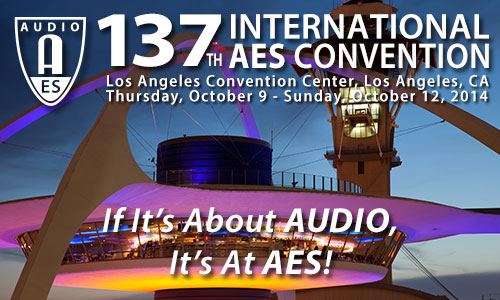
AES Los Angeles 2014
Paper Session P6
Friday, October 10, 9:00 am — 12:00 pm (Room 308 AB)
Paper Session: P6 - Spatial Audio: Part 3
Chair:
Bob Schulein, RBS Consultants - Schaumburg, IL, USA
P6-1 PHOnA: A Public Dataset of Measured Headphone Transfer Functions—Braxton B. Boren, Princeton University - Princeton, NJ, USA; Michele Geronazzo, University of Padova - Padova, Italy; Piotr Majdak, Austrian Academy of Sciences - Vienna, Austria; Edgar Choueiri, Princeton University - Princeton, NJ, USA
A dataset of measured headphone transfer functions (HpTFs), the Princeton Headphone Open Archive (PHOnA), is presented. Extensive studies of HpTFs have been conducted for the past twenty years, each requiring a separate set of measurements, but this data has not yet been publicly shared. PHOnA aggregates HpTFs from different laboratories, including measurements for multiple different headphones, subjects, and repositionings of headphones for each subject. The dataset uses the spatially oriented format for acoustics (SOFA), and SOFA conventions are proposed for efficiently storing HpTFs. PHOnA is intended to provide a foundation for machine learning techniques applied to HpTF equalization. This shared data will allow optimization of equalization algorithms to provide more universal solutions to perceptually transparent headphone reproduction.
Convention Paper 9126 (Purchase now)
P6-2 Converting Two-Channel Stereo Signals to B-Format for Directional Audio Coding Reproduction—Mikko-Ville Laitinen, Aalto University - Espoo, Finland
A method for transforming two-channel stereo audio signals to B-format is proposed, which provides unaltered spatial qualities when the B-format signals are reproduced with directional audio coding (DirAC). The proposed method simulates anechoic B-format recordings of the stereo signals with two different virtual loudspeaker configurations, and the simulated B-format signals are combined according to time-frequency analysis of the stereo signals. The analysis is based on estimating the diffuseness of the generated virtual sound field and the coherence between the loudspeaker channels.
Convention Paper 9127 (Purchase now)
P6-3 Binaural Reproduction over Loudspeakers Using Low-Order Modeled HRTFs—Kentaro Matsui, NHK Science & Technology Research Laboratories - Setagaya, Tokyo, Japan; Keio University - Yokohama-shi, Kanagawa, Japan; Yasushige Nakayama, NHK Science & Technology Research Laboratories - Setagaya-ku, Tokyo, Japan; Maho Sugaya, Keio University - Yokohama-shi, Kanagawa, Japan; Shuichi Adachi, Keio University - Yokohama-shi, Kanagawa, Japan
A method for binaural reproduction over loudspeakers using low-order modeled head-related transfer functions (HRTFs) is proposed. The low-order modeling consists of two steps: high-order model estimation using a prediction error method and subsequent model reduction based on asymptotic theory. Binaural processing over loudspeakers using the low-order modeled HRTFs is done in the time domain. In general, the directly derived controller for crosstalk cancellation is unstable, and so a method for approximating the unstable components in the controller as stable ones with processing delays is proposed. Results of computer simulation indicated that the designed controller worked well for producing equalization and crosstalk cancellation.
Convention Paper 9128 (Purchase now)
P6-4 Assessment of Ambisonic System Performance Using Binaural Measurements—Eric M. Benjamin, Surround Research - Pacifica, CA, USA; Aaron Heller, SRI International - Menlo Park, CA, USA
The phenomenon described by Solvang as spectral impairment in Ambisonic reproduction is examined. The timbre of reproduced sounds is arguably the most important aspect of an audio system. In multichannel systems audio is almost always reproduced through two or more loudspeakers simultaneously. The combination of those audio signals produces variable localization, but interference between them also causes comb filtering that then causes a reduction in output at high frequencies. The present work reports on measurements, including binaural measurements, of the spectral changes encountered in Ambisonic systems. In the case where a system has more loudspeakers than the minimum required the amount of interference is increased. What is the best choice for the use of an array designed for higher-order reproduction when used to reproduce lower-order program?
Convention Paper 9129 (Purchase now)
P6-5 The Design, Calibration, and Validation of a Binaural Recording and Playback System for Headphone and Two-Speaker 3D-Audio Reproduction—Bob Schulein, RBS Consultants - Schaumburg, IL, USA; Dan Mapes-Riordan, Etymotic Research - Elk Grove Village, IL, USA; DMR Consultants - Evanston, IL, USA
The evolution of iOS, Android, Windows Mobile, and other operating systems has fueled a rapid growth in personal entertainment products and has revolutionized the way consumers receive, control, and listen to audio content. Headphones or earphones and two-speaker stereo have become the dominant means of listening. Multichannel /speaker audio systems in contrast are primarily a part of the motion picture and home theater experience and can create audio content with richer spatial content. This 3D or immersive audio experience is desired by consumers but is not a part of the typical listening experience. Binaural sound, reproduced by headphones or two speakers, using cross-talk cancellation techniques, has been shown to provide significant spatial audio benefits when properly implemented. This paper presents a detailed look as to how these technologies are being refined and applied today to create entertainment content with significantly improved spatial qualities.
Convention Paper 9130 (Purchase now)
P6-6 Analytical Interaural Time Difference Model for the Individualization of Arbitrary Head-Related Impulse Responses—Ramona Bomhardt, RWTH Aachen University - Aachen, Germany; Janina Fels, RWTH Aachen University - Aachen, Germany
If dummy head or individual Head-Related Impulse Responses (HRIR) are used for binaural reproduction, either it can result in an incorrect perception of virtual sound sources or poses an enormous measurement effort. Therefore, in this paper a model is presented that helps to calculate the Interaural Time Difference by anthropometric head-data. By means of this Interaural Time Difference, the time of arrival of arbitrary HRIRs can be individualized. This model is compared with 13 individual measured HRIRs and the subjects' anthropometric head-data. The result of comparison leads to the conclusion that the model works well to individualize the Time of Arrival of an arbitrary HRIR.
Convention Paper 9131 (Purchase now)
